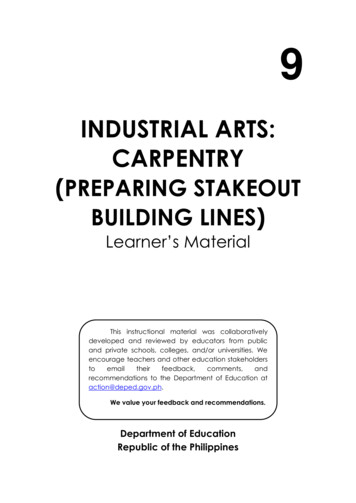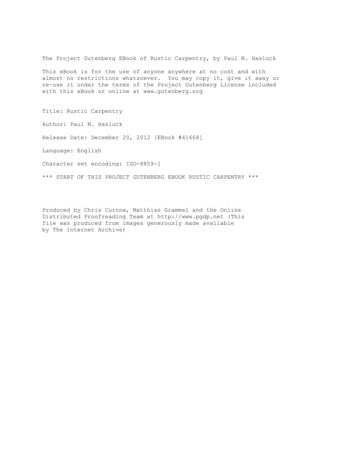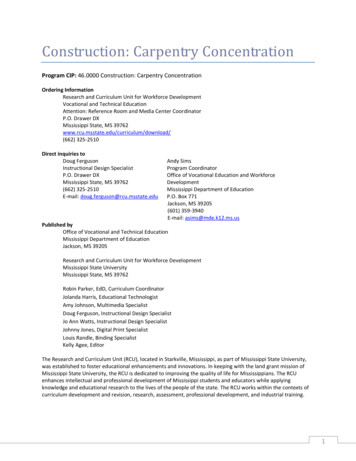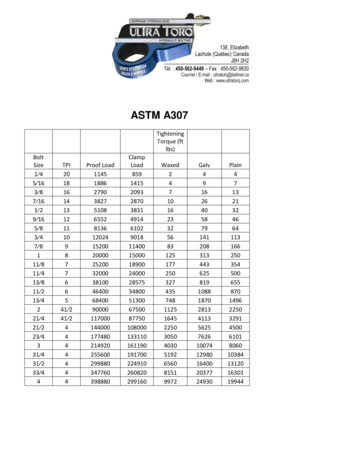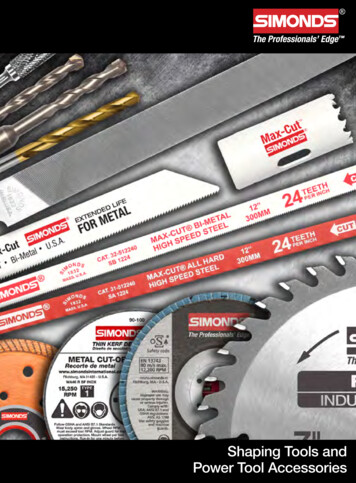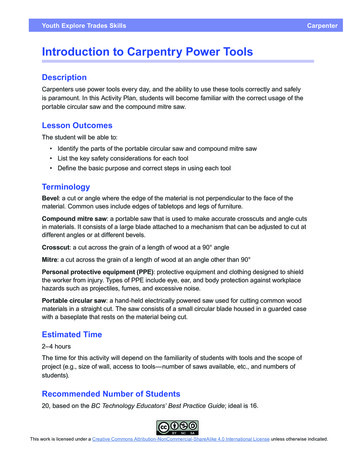
Transcription
Youth Explore Trades SkillsCarpenterIntroduction to Carpentry Power ToolsDescriptionCarpenters use power tools every day, and the ability to use these tools correctly and safelyis paramount. In this Activity Plan, students will become familiar with the correct usage of theportable circular saw and the compound mitre saw.Lesson OutcomesThe student will be able to: Identify the parts of the portable circular saw and compound mitre saw List the key safety considerations for each tool Define the basic purpose and correct steps in using each toolTerminologyBevel: a cut or angle where the edge of the material is not perpendicular to the face of thematerial. Common uses include edges of tabletops and legs of furniture.Compound mitre saw: a portable saw that is used to make accurate crosscuts and angle cutsin materials. It consists of a large blade attached to a mechanism that can be adjusted to cut atdifferent angles or at different bevels.Crosscut: a cut across the grain of a length of wood at a 90 angleMitre: a cut across the grain of a length of wood at an angle other than 90 Personal protective equipment (PPE): protective equipment and clothing designed to shieldthe worker from injury. Types of PPE include eye, ear, and body protection against workplacehazards such as projectiles, fumes, and excessive noise.Portable circular saw: a hand-held electrically powered saw used for cutting common woodmaterials in a straight cut. The saw consists of a small circular blade housed in a guarded casewith a baseplate that rests on the material being cut.Estimated Time2–4 hoursThe time for this activity will depend on the familiarity of students with tools and the scope ofproject (e.g., size of wall, access to tools—number of saws available, etc., and numbers ofstudents).Recommended Number of Students20, based on the BC Technology Educators’ Best Practice Guide; ideal is 16.This work is licensed under a Creative Commons Attribution-NonCommercial-ShareAlike 4.0 International License unless otherwise indicated.
Introduction to Carpentry Power ToolsCarpenterFacilitiesTechnology education shop facility required. Secure space to work outside is advantageous.Tools Aprons Eye protection and hearing protection (PPE) Compound mitre saw Portable circular saw Extension cord (if necessary) Sawhorses for supporting material being cutMaterials2 4" or 2 6" scraps for practice cuttingResourcesHEADS UP! For Safety—A Safety Handbook for Technology Education Teachers—Ministry of dsup.pdf Portable Power Tools Safety Information Sheet, page 49 Portable Power Tools Safety Quiz, page 50 Portable Circular Saw Information Sheet, page 61 Portable Circular Saw Safety Quiz, page 62Compound Mitre Saw Safety Sheet2Youth Explore Trades Skills
CarpenterIntroduction to Carpentry Power ToolsDemonstration: Portable Circular Saw1. Outline the purpose of the activity and review the importance of general safety on the jobsite.2. Have students read through the Heads Up! For Safety – Portable Power Tools SafetyInformation Sheet. This can be preceded or followed by a short introduction to portablepower tool safety.3. Students should complete the Heads Up! – Portable Power Tools Safety Quiz. Studentscan group mark the quiz or the teacher can collect and mark them.4. The teacher should begin the activty with a demonstration of the parts of the saw. It shouldconsist of: Type of blade used and method of removing and attaching the blade Arbor nut holding the blade in position Saw base Guard Blade depth adjustment Blade angle adjustment Electrical cord (or battery pack if cordless)Trigger switchSafety switchMotor housingElectrical cordBevel cutting angleadjustment knobLever for retractinglower blade guardHandleFront clamp screwRetracting lowerblade guardMain shoeShoeCutting depthadjustment knobFigure 1—Circular saw nomenclatureYouth Explore Trades Skills3
Introduction to Carpentry Power ToolsCarpenterLeft side of theblade at 45 Left side of theblade at 90 Figure 2—Guide marks5. Have the students read the Heads Up!—Portable Circular Saw Information Sheet.6. Then demonstrate the use of the saw. Have the students wear PPEs as they watch.7. Have the students individually complete the Heads Up!—Portable Circular Saw SafetyQuiz. As this is a legal safety requirement, students must be thorough and complete allaspects of the quiz in the allotted time.8. Collect and mark the safety quiz (to be given back the following day).4Youth Explore Trades Skills
CarpenterIntroduction to Carpentry Power ToolsDemonstration: Compound Mitre Saw1. Begin the compound mitre saw activty with a demonstration of the parts of the saw. Itshould consist of: Type of blade used and method of removing and attaching blade Arbor nut holding the blade in position Saw table Saw fence Guard Mitre adjustment mechanism (varies from saw to saw) Bevel adjustment mechanism (varies from saw to saw) Electrical cord2. Have the students read the Compound Mitre Saw Safety Sheet (on the next page).3. When the students have completed their reading, demonstrate the use of the saw. Have thestudents wear PPEs as they watch. The teacher should demonstrate a variety of 90 cuts,mitre cuts and bevel cuts.Emphasis should be on clamping material if possible, hands away from the blade path,letting the blade reach top speed before cutting, and moving out and down in with the actualcut. The saw should not be lifted from the bottom of the cut until the blade is fully stoppedor the material may catch and kick away from the machine.Evaluation GuidelinesThe student: Successfully completes the Heads Up! Portable Power Tools Safety Quiz Successfully completes the Heads Up! Portable Circular Saw Safety QuizYouth Explore Trades Skills5
Introduction to Carpentry Power ToolsCarpenterCompound Mitre Saw Safety SheetFigure 3—Compound mitre saw1. Be sure all guards are in place and working properly before each use.2. When changing a blade, always match the direction of the arrow on the blade with thedirection of the arrow on the tool. The teeth at the bottom of the blade should point downand in toward the fence.3. Be sure the arbor nut is tight to prevent slipping.4. Place the saw on a flat and level surface.5. Always wear safety glasses or a face shield. Hearing protection is recommended.6. Remove loose-fitting clothing and jewellery, and tie back long hair.7. Always place the material securely on the table and against the fence when making cuts.8. Whenever possible, use clamps to secure the material to the table to avoid injuries.9. Never make freehand cuts without holding the material tightly against the fence.10. Never cut small pieces that would require you to put your fingers within 3" of the cuttingblade without a clamping device.11. Never reach across the saw blade or perform “cross-handed” operation.12. When starting the saw, allow the blade to reach full speed before cutting; do not force theblade. Let the motor do the work.13. When using a sliding compound mitre saw, remember to pull the blade out, start the saw,and then push down into the stock and toward the fence.14. Never raise the blade from the material until the blade has come to a complete stop.15. Never try to remove or clamp any material to the saw while the blade is rotating.6Youth Explore Trades Skills
CarpenterIntroduction to Carpentry Power ToolsAppendix: Mitre Saw InformationTypesCarpenters use portable mitre saws to cut mouldings and finish wood as well as to fit and cutframing lumber to length.There are three basic types of mitre saws: Mitre Compound mitre Sliding compound mitreA sliding compound mitre saw has a sliding device that allows the motor and blade to slide alonga track. This allows the saw to cut much wider boards.On most job sites, a power mitre saw is simply called a chopsaw. There are a great number ofsizes and styles—from standard single-pivot chopsaws through dual compound mitre saws.Figure 4 shows a single-pivot type.Figure 4—Standard chopsawSizesThe size of a mitre saw is determined by the maximum diameter of the blade that it can use.Most mitre saws are 8, 10, or 12" saws. Twelve-inch diameter blades are not as common.The power of the saw is determined by the size of the motor. As portable tools, they must usea 120-volt power source. This limits the power of the saw. The 12" saws are usually underpowered and tend to slow when cutting wide or thick boards.Youth Explore Trades Skills7
Introduction to Carpentry Power ToolsCarpenterCompound Mitre SawThis saw mitres like a standard chopsaw, but the blade and motor assembly also can flop overto one side, allowing the user to cut a bevel with the face of the board lying flat on the table.The sliding compound mitre saw can cut mitres, bevels, and compound mitres like a compoundmitre saw. But instead of a fixed pivot point, the blade and motor can slide forward and back ona rail. A sliding saw can cut wider stock than a fixed pivot head saw.Figure 5—Compound mitre sawFigure 6—Single sliding compound mitre sawDouble-Bevel Compound Mitre SawThis saw functions exactly like a compound mitre saw, except that the blade and motorassembly can flop either to the left or to the right, allowing for the cutting of bevels andcompound mitres in either direction.Double-bevel sliding compound mitre saws function the same as double-bevel compound mitresaws, but they also can slide back and forward on a rail.Figure 7—Double-bevel compound mitre saw8Figure 8—Double-bevel slidingcompound mitre sawYouth Explore Trades Skills
CarpenterIntroduction to Carpentry Power ToolsOperating ControlsTo turn the saw on, depress the trigger switch (A).Release the switch to turn if off.Warning: The turning blade is dangerous. Aftercompleting the cut, release the switch trigger to activatethe brake. Keep the saw head down until the blade hascome to a complete stop.The torque developed during braking may loosenthe arbor screw. The arbor screw should be checkedperiodically and tightened if necessary.Figure 9—ON–OFF trigger switchRotating TableThe mitre saw shown in Figure 10 will cut any mitre angle from a straight 90 cut-off to 47 rightor left. Simply loosen the lock handle (A), depress the index lever (B), and move the control armto the desired angle. Then tighten the lock handle (A).The 10" compound mitre saw isequipped with positive mitre stops forthe table control arm at the 0, 15, 22½,30, and 45 right and left positions.Loosen the lock handle (A) and movethe control arm until the spring-loadedindex lever (B) engages into one of thepositive stops (four of which are shownat (C) ). Then tighten the lock handle (A).To disengage the positive stop, depressthe index lever (B).Important: Always tighten the lockhandle (A) before cutting.In addition, two triangle indicators (D)are provided on the scale at the 31 right and left mitre angle, for cuttingcrown moulding.Youth Explore Trades SkillsFigure 10—Rotating table9
Introduction to Carpentry Power ToolsCarpenterTilting ArmThe cutting arm of the compound mitre saw can be tilted to cut at any bevel angle from a 90 straight cut-off to a 45 left bevel angle by loosening the bevel lock handle (A) (Figure 11), tiltingthe cutting arm to the desired angle, and tightening the lock handle (A).Note: The lock handle (A) is spring-loaded and can be positioned by pulling out on the handleand repositioning it on the nut located underneath the hub of the handle.Positive stops are provided to rapidly position the saw blade at 90 and 45 to the table. Thebevel angle of the cutting arm is determined by the position of the pointer (B) on the scale (C).In addition, a triangle indicator (D) is provided on the scale at the 33 bevel angle for cuttingcrown moulding.Figure 11—Bevel cutting10Youth Explore Trades Skills
CarpenterIntroduction to Carpentry Power ToolsLocking ArmWhen transporting the saw, the cutting arm should always be locked in the down position.This can be accomplished by lowering the cutting arm (A) (Figure 12) and moving the lockinglever (B) to the locked position. Never carry the mitre saw by the switch handle, cutting armor table control; this may cause misalignment. Always lift the saw by its base.Figure 12—Locking cutting armFastening HolesFastening holes are provided in the base of the saw castingfor mounting. Always secure the saw with screws to preventmovement. A walking saw is always dangerous.Figure 13—Fastening holesYouth Explore Trades Skills11
Introduction to Carpentry Power ToolsCarpenterMitre Saw AdjustmentDISCONNECT THE SAW FROM THE POWER SOURCE BEFORE MAKING ANYADJUSTMENTS.Two-Position FenceThe fence (A) on your mitre saw can be used in the forward position, as shown in Figure 14, orin the rear position, as shown in Figure 15. The forward position is used for cutting workpiecesup to a standard 4 4" and is the most common fence position.The rear fence position is used when cutting off or bevelling standard 2 6" workpieces.To change the fence position, loosen the two fence locking screws, one of which is shownat (B). Position the fence (A) in either the forward or rear position and tighten the two fencelocking screws (B).Figure 14—Fence in forward positionFigure 15—Fence in rear positionTo quickly check to see if the saw is cutting square, cut a 2 6", flip the cut piece over, and buttit against the edge from which you cut. If the workpiece does not butt squarely, an adjustment isrequired (Figures 16 and 17).Figure 16—Checking bevel error12Figure 17—Bevel errorYouth Explore Trades Skills
CarpenterIntroduction to Carpentry Power ToolsAdjusting a 90 Bevel StopLoosen the bevel lock handle, tilt the cutting arm all the way to the right, and tighten the bevellock handle. Place one end of a square (A) (Figure 18) on the table and the other against theblade. Check to see if the blade is at 90 to the table. If an adjustment is necessary, loosenlocknut (B) (Figure 19)
Introduction to Carpentry Power Tools Description Carpenters use power tools every day, and the ability to use these tools correctly and safely is paramount. In this Activity Plan, students will become familiar with the correct usage of the portable circular saw and the compound mitre saw. Lesson Outcomes The student will be able to: Identify the parts of the portable circular saw and .



